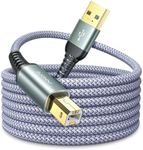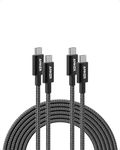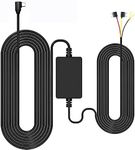Buying Guide for the Best USB-C Cables
Choosing the right USB-C cable can make a big difference in how quickly your devices charge, how fast data transfers, and how reliable your connections are. Not all USB-C cables are created equal—some are designed for fast charging, others for high-speed data transfer, and some are just basic for simple tasks. Understanding the key specifications will help you pick a cable that matches your needs, whether it's for charging your phone, connecting to a laptop, or transferring large files.Cable LengthCable length refers to how long the USB-C cable is, usually measured in meters or feet. This is important because a longer cable gives you more flexibility to use your device while it's charging, but it can also lead to slower charging or data transfer if the cable isn't high quality. Short cables (under 1 meter) are great for desktop use or when you want the fastest charging and data speeds. Medium cables (1-2 meters) offer a balance between convenience and performance, suitable for most everyday uses. Long cables (over 2 meters) are best when you need to reach faraway outlets, but make sure the cable is well-made to avoid performance drops. Choose the length based on where and how you'll use the cable most often.
Power Delivery (Wattage)Power Delivery, often shown as a wattage rating (like 18W, 60W, or 100W), tells you how much power the cable can safely carry for charging devices. This is crucial if you want to charge laptops, tablets, or fast-charge smartphones. Lower wattage cables (under 30W) are fine for phones and small gadgets. Mid-range (30W-60W) can handle tablets and some smaller laptops. High wattage (60W-100W) is needed for larger laptops and fast charging. Check what your device needs and pick a cable that matches or exceeds that wattage for safe and efficient charging.
Data Transfer SpeedData transfer speed is how quickly information can move between devices using the cable, usually measured in megabits or gigabits per second (like USB 2.0 at 480Mbps, USB 3.0 at 5Gbps, or USB 3.1/3.2 at 10Gbps and above). If you only use the cable for charging, speed isn't a big deal. But if you transfer files, photos, or videos, a faster cable saves time. Basic cables (USB 2.0) are fine for charging and simple tasks. Mid-range (USB 3.0/3.1) are good for most data needs. High-speed cables (USB 3.2, Thunderbolt) are best for large files or connecting to monitors. Match the speed to your typical use.
Build Quality and DurabilityBuild quality covers how sturdy the cable is, including the materials used for the outer jacket, connectors, and internal wiring. This matters because a well-made cable lasts longer, resists tangling, and is less likely to break or fray. Basic cables may use simple plastic and are fine for light use. Reinforced or braided cables are tougher and better for travel or heavy use. If you often plug and unplug your cable or carry it around, look for features like reinforced ends or braided exteriors for extra durability.
Certification and CompatibilityCertification means the cable has been tested to meet certain standards, like USB-IF certification, which ensures safety and performance. Compatibility refers to whether the cable works with your devices, especially for features like fast charging or video output. Certified cables are more reliable and safer, especially for expensive devices. If you need special features like video output (for monitors) or fast charging, make sure the cable supports those functions. Always check your device's requirements and look for cables that clearly state compatibility with your gadgets.
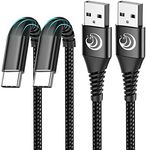

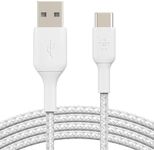



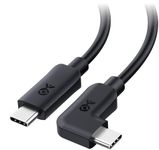


![Anker USB C Cable, [2-Pack, 6 ft] T](https://images-proxy.bestreviews.guide/VDyk298ucaN0d_xq2mlrQw-l53Y=/0x150/https://m.media-amazon.com/images/I/51PX8Vo4fRL._AC_CX679_.jpg)


![LISEN USB C to USB C Cable 240W, [6.6ft 2Pack] Nylon Braided Type C Cable Fast Charge for iPhone 17 Pro Max USBC Fast Charging Cord for iPhone Air 17 16 Samsung MacBook Pro M5 iPad Air Xbox, Midnight](https://images-proxy.bestreviews.guide/haM6y5W-mmp6dRZMcu93A8x99VA=/0x150/https://m.media-amazon.com/images/I/61lM70SX7QL._AC_CX679_.jpg)
